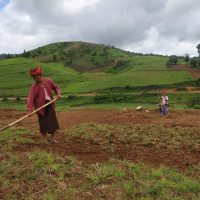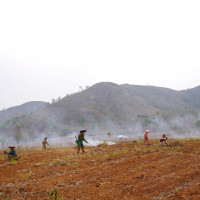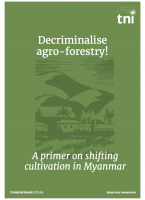‘There is no vacant land’ A primer on defending Myanmar’s customary tenure systems
Topics
Regions
This Primer promotes a deeper understanding and appreciation of Myanmar's customary tenure systems, which are under threat from the government's new land policies. It looks at the nature and origin of traditional land and resource use customs and the functions these fulfill in Myanmar's rural communities.

Downloads
Authors
Summary
Across the world, the livelihoods and well-being of rural communities have, since time immemorial, been assured through their customary land and resource management systems. Myanmar is no exception, and these systems have been especially valued in ethnic upland areas. Although increasingly under pressure, these systems still widely continue more or less intact, and continue to retain social legitimacy.
Customary tenure systems involve rural communities asserting authority over their local land and resources within their village areas, allocating rights and regulating access and use according to traditional cultural norms. At the simplest these institutions are codified social norms around resource access, and as such have existed across just about every inhabited landscape in the world.
They often involve the coordination of farming activities like planting, harvesting and grazing. They are based on a strong local identification with place and ecological landscape, and have evolved dynamically over the long term, giving rise to unique cultural landscapes. They tend to be sophisticated, flexible, and practical in terms of combining common and private rights and responsibilities across diverse resources. Beyond individual villages, they can play a key role in agreeing to inter-village boundaries, and regulating across clusters of villages who gets access to what resources, when and how. They can manage disputes both within and between villages in ways which have cultural legitimacy and embody principles of social justice. Their effectiveness is reflected in how highly valued they are by the communities who rely on them, and they evolve as the social composition and economic needs of the communities evolve and change over time.
There is increasing recognition of the prevalence of these systems and the importance to rural communities who rely on them. A recent study estimated that as much as 65% of the world’s land areas is managed under customary systems (RRI 2015). Across rural areas of Asia, Europe the Americas, and Africa, a wide diversity of customary land governance systems have been documented and continue to function effectively, with varying levels of state recognition. There are a wide diversity of customary systems across Myanmar, which go by a range of different local terms.
The recognition, understanding and study of common property and customary systems has been enjoying a remarkable renaissance around the world in recent decades. Academic research has demonstrated that customary systems are highly effective in enabling land and resource use that supports social well-being of ethnic communities. This is partly for economic reasons - because it can be highly efficient in delivering land and resource governance and management at relatively low cost with little conflict – and partly for social reasons – that they reflect reciprocal social relations over material resources.
However these systems are almost always misunderstood by outsiders, who without direct experience of them rarely seem to grasp the now all too unfamiliar concepts of local self-management, shared property (land and resources held in common) and social reciprocity (for instance labour exchange, and collective cropping). Negative judgements are frequently indulged in (‘unequal’, ‘anti-women’, ‘feudalistic’, ‘outdated’) with little basis in evidence, or time being taken to understand them properly.
Misunderstanding can have serious consequences - policies commonly fail to represent these systems correctly, recognise their value, or protect their key elements. Misrepresentation has been common around the world, as customary systems have been over-ruled by colonial land administration centralisation:
How far these [mis]conceptions arose from ignorance or were deliberate has long been debated, every decade of persistence favouring the latter (Alden Wily, 2006a).
In Myanmar, these systems have begun to be eroded and undermined in recent decades, and many customary villages and village clusters are now either in crisis or feeling profoundly threatened. War, militarization and land and natural resource grabbing have already displaced many villagers and communities from their customary lands. Myanmar’s long-running military dictatorship ignored communities’ rights and treated community land and resources as ‘land at government disposal’, and in 2012 the government officially re-labelled them as ‘Virgin, Fallow and Vacant’. The Tatmadaw (Myanmar national army), as well as some other armed groups in the country, have summarily appropriated land and resources for themselves or their business partners, overriding village authority using menace or actual violence.
Although many customary systems have been able to persist, they are often hanging on by a thread. And as the country struggles towards democracy, economic development, and peace, new threats to customary lands and resource systems loom even larger. At the moment there is not yet even any statutory category through which to acknowledge customary systems and village land and resources held in common, and key influential actors appear to be preventing such recognition from attaining legal status.
At the same time urban-based administrators seem to be envisioning large scale ‘modern’ economic enterprises across Myanmar’s lands, in plans and visions that seem to imply that customary village resource management systems are either an impediment to ‘development’ or don’t even exist.
In reality, most of the land being labelled ‘vacant’ or ‘virgin’ land is actually customary village property, so implementing this law amounts to unjust appropriation of village property without acknowledgement of pre-existing rights or claims and thus violates several international norms and conventions. The third category - ‘fallow’ lands - at least recognises that the land is under use, but then reallocation of an already utilised resource seems all the more blatantly unjust.
Reallocating land and related natural resources without recognising and settling the pre-existing rights according to a due process is widely understood as intrinsically unjust and it particularly goes against the norms agreed to by many of the world’s governments in the 2012 FAO Tenure Guidelines (FAO 2012), to which Myanmar is a signatory. Indeed, much of Part 3 of these FAO Guidelines – especially section 9 in its entirety - is devoted particularly to spelling out when and how the rights of indigenous peoples and communities with customary tenure systems must be fully recognized and protected from reallocation, eviction and any legislative or administrative initiatives that would facilitate these. Yet this is happening widely, particularly in ongoing conflict zones and promoted by powerful military and commercial interests in the Myanmar government. The inescapable conclusion must be that it is part of a hostile economic, political and military strategy, and along with other recent notorious actions of the Tatmadaw, infringes the Geneva Conventions 1949, which states:
... Reprisals against protected persons and their property are prohibited ( Geneva Convention IV Article 33).
In January 2019 seven United Nations special Rapporteurs for protection of a range of human rights addressed their concerns over the VFV Amendment to the Government of Myanmar:
‘we are concerned that this law may be used to illegally dispossess land users of their land without due process or adequate notice, undermine their human rights, and have a dispropoirtionate impact on poor, rural and minority communiteis, ethnic nationalities and indigenous peoples’
Internationally there is increasing emphasis across multilateral organisations and fora on the fundamental importance of proper protection and recognition of rights and tenure, and the adherence to basic norms of good land and resource governance (FAO 2012), as a basis for development. The UN Sustainable Development Goals, to which Myanmar is a signatory, state:
Sustainable development goal 1 – End poverty in all its forms everywhere.
- Target 1.4 by 2030 ensure that all men and women, particularly the poor and the vulnerable, have equal rights to economic resources, as well as access to basic services, ownership, and control over land and other forms of property, inheritance, natural resources, ...
Sustainable development goal 2 - End hunger, achieve food security and improved nutrition and promote sustainable agriculture.
- Target 3 –By 2030, double the agricultural productivity and incomes of small-scale food producers, in particular women, indigenous peoples, family farmers, pastoralists and fishers, including through secure and equal access to land, other productive resources and inputs, knowledge, financial services, markets and opportunities for value addition and non-farm employment.
Sustainable development goal 5 - Achieve gender equality and empower all women and girls.
- Target 7 – give women equal access to economy resources as well as access to ownership and control over land and other forms of property.
In most customary tenure systems the ownership and control referred to in the UN SDGs is already assured, and it is assured collectively.
Where a local system is working reasonably well and is not subject to significant outside pressures that stress the system beyond its ability to adapt and mediate conflicts, outsiders should not interfere (Freudenberger 2013).
Despite all these norms and principles Myanmar’s Government has been interfering in and undermining these systems, and therefore undermining its own international commitments as well as the achievement of these development goals. A new amendment to the VFV law 2012 passed in September 2018, making continued occupation, without official permission, of land which is not municipal, private or state (i.e. land which is de facto customary) a criminal offence.
Yet there still remains no provision to clarify the pre-existing and as yet unrecognised, mainly customary, community rights. Customary systems and the wellbeing of those who depend on them are now gravely threatened by this law.
Few outside of ethnic areas fully appreciate what the customary tenure systems actually are, how they work, and how centralised authorities, statutory policies and jurisdictions undermine them in practice. It is time to recognise customary resource systems in law, and acknowledge these systems as the foundation of wellbeing in many rural areas. But in order to protect ethnic well-being and ensure post-conflict recovery, it is essential that these customary tenure systems are understood. This primer seeks to clarify the issues, improve understanding of customary land tenure systems and explore what should be done.
The non-recognition of the customary tenure systems of Myanmar’s ethnic groups is one of the key drivers of ethnic conflict in the country. It is related not only to respect and support of socio-economic and political systems of ethnic groups, but also closely related to the right to land for IDPs and refugees. Without addressing these issues, the prospects for national peace and development are grim.
The primer is divided into 6 sections. First, it examines the key elements of these systems and how they function. Second, it considers their prevalence and continuity around the world. Third, it considers their characteristics, importance, and relative pros and cons. Fourth, it look at the changing conditions and fifth at current policy dynamics affecting customary systems. Last, it offers some recommendations.



